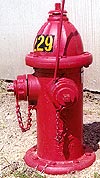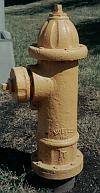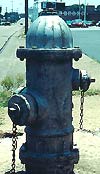
|

|
||
|
1948 Nozzles: 2x 2½" Size: 5¼" V.O. Dated: 1936 Patent Date: 1918 Model: Standard Underwriter type Location: Mark P. collection Photo: © 2003, M. Pandanell |
1071 Nozzles: 2x 2½" Size: 5¼" V.O. Dated: 1946 Model: Standard Underwriter type Location: Ed M. collection Photo: © 2001, E. Masminster |
|
|
This hydrant is called the "UL Chattanooga Style" model. Nearly identical to the hydrants above, it appears that the Columbian name was dropped from Mueller hydrants at this point in time. UL/FM hydrants are typically
in private installations such as warehouses, powerplants, factories, etc.
These are examples of the original style with the smooth bonnet cast integral with the upper barrel ... |

|

|

|

|
|
2140 Nozzles: 2x 2½" Size: 5¼" V.O. Dated: 1963 Location: John A. collection Photo: © 2003, J. Anderson |
1183 Nozzles: 2x 2½" externally gated Size: 5¼" V.O. Dated: 1956 Location: Robert F. collection Photo: © 2001, R. Frye |
1067 Nozzles: 3x 2½" externally gated Size: 5¼" V.O. Dated: 1960 Location: Massachusetts Photo: © 2001, J. Kaminski |
0311 Nozzles: 2x 2½", 1x ~4" Size: ~5¼" V.O. Dated: ? Location: ? Photo: © E. Kennedy |

|
|||
|
2382 Nozzles: 3x 2½", externally gated Size: ~6¼" V.O. Dated: 1953 Location: Private collection Photo: © J. Kaminski |
|
These are the later style with a bolted on bonnet style...
|

|
|||
|
0735 Nozzles: 2x 2½" Size: 5¼" V.O. Dated: 1966 Note: fluted bonnet Location: Dubuque, IA Photo: © 2000, J. Anderson |
|
These next 4 models can be easily confused with each other: Standard, Improved, 107, and
Centurion/Super Centurion. This confusion is compounded by the fact that only the 107 model
has the model designation cast onto the hydrant. They collectively are what most people
know as "Mueller hydrants".
|
|
|
The Standard model differs from the other similar models by the lack of operating nut
weather cap and the conventional (no skirt) barrel joint.
|

|

|

|

|
|
0296 Nozzles: 1x ~4" Size: 4½" V.O. Dated: ? Location: ? Photo: © E. Kennedy |
1069 Nozzles: 2x 2½" Size: 4¼" V.O. Dated: 1963 Location: Ed M. collection Photo: © 2001, E. Masminster |
1068 Nozzles: 2x 2½", 1x 4½" Size: 4¼" V.O. Dated: 1961 Location: Ed M. collection Photo: © 2001, E. Masminster |
1070 Nozzles: 2x 2½" Size: 5¼" V.O. Dated: 1959 Location: Ed M. collection Photo: © 2001, E. Masminster |

|

|

|

|
|
2139 Nozzles: 2x 4½" Size: 5¼" V.O. Dated: 1971 Location: John A. collection Photo: © 2003, J. Anderson |
1435 Nozzles: 2x 2½", 1x 4½" Size: 5¼" V.O. Dated: 1967 Location: Galena, IL Photo: © 2001, J. Anderson |
2117 Nozzles: 2x 2½", 1x 4½" Size: 5¼" V.O. Dated: 1964 Location: John A. collection Photo: © 2003, J. Anderson |
0410 Nozzles: 2x 4½" Size: 6¼" V.O. Dated: 1966 Location: Memphis, TN Photo: © E. Kennedy |

|
|||
|
0691 Nozzles: 1x 2½", 2x ~4" Size: 6¼" V.O. Dated: ? Location: Memphis, TN Photo: © E. Kennedy |
|
|
The 2 1/8" V.O. Standard Post model was designed as a yard hydrant.
|

|

|

|

|
|
2359 Nozzles: 1x 1½" Dated: 1959 Location: Private collection Photo: © 2006, Jeff Kaminski |
0131 Nozzles: 1x 2½" Dated: 1958 Location: Ed M. collection Photo: © 2001, E. Masminster |
2358 Nozzles: 2x 1½" Dated: 1969 Location: Private collection Photo: © 2006, Jeff Kaminski |
1180
Nozzle: 1x 2½" Dated: 1991 Location: Robert F. collection Photo: © 2001, R. Frye |
|
|
In a 1941 Mueller brochure this is called the Mueller - Columbian Standard fire hydrant. It lacks both the barrel fluting below the "false"
O.D. rib and the bonnet fluting making it different from any hydrants in this group. A Mueller-Columbian advertisement from the 1930s highlights the traffic feature of this hydrant.
According to the ordering instructions in the brochure cited above, the Mueller-Columbian Standard was: Catalog Number A24005 4¼" Catalog Number A24007 5¼" Catalog Number A24004 6¼". Source: 1941 Mueller-Columbian Standard fire hydrant brochure, Form 8720, 1-1-41, page 3. |

|
|||
|
0124 Nozzles: 2x 2½", 1x 4½" Size: 5¼" V.O. Dated: ? Note: smooth bonnet Location: Charlottesville, VA Photo: © E. Kennedy |
|
Dry Barrels - Part 1 , Part 2 , Part 3 | Wet Barrels Unless otherwise noted, all contents of these WWW pages © FireHydrant.org |